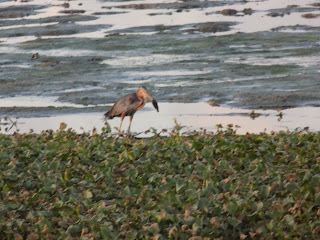The Rose-ringed Parakeet/ Ring-necked Parakeet (Psittacula krameri) locally known as Pachchai Kili (பச்சை கிளி).
The Rose-ringed Parakeet (Psittacula krameri) near Medavakkam lake (Photo credit: U Elaya Perumal)
In the Medavakkam Marshland area we could observe more rose-ringed parakeets. they live on the palm trees near Medavkkam lake. Every day they fly through Annakkili Amma Research Institute and also often land on backyard trees of AARI.
The Rose-ringed Parakeet (Psittacula krameri) near AARI (Photo credit: U Elaya Perumal)
The ring-necked parakeet, is a medium-sized parrot in the genus Psittacula, of the family Psittacidae. It has disjunct native ranges in Africa and the Indian Subcontinent and is now introduced into many other parts of the world where feral populations have established themselves and are bred for the exotic pet trade. Even in Chennai, it is illegally traded on many pet markets, for example at Chennai Pallavaram Friday market.
The Rose-ringed Parakeet (Psittacula krameri) near Medavakkam lake (Photo credit: U Elaya Perumal)
Vibrantly bright green parakeet, frequently found in woodland, parks, gardens, where feeds mainly in trees. Nests in cavities, including holes in buildings. Easily overlooked if quiet, as the bright green plumage blends easily with foliage. Note the very long slender tail, bright red bill; male has narrow black-and-rose neck ring. Closely resembles the larger Alexandrine Parakeet, which has a wine-red patch on each shoulder. Like other parakeets, raucous and social, often appearing in noisy groups. Native to Africa and South Asia, introduced locally in Europe and Japan (Source: ebirds).
The Rose-ringed Parakeet (Psittacula krameri) in Tanjavur (Photo credit: U Elaya Perumal)
Scientific classification
Kingdom : Animalia
Phylum : Chordata
Class : Aves
Order : Psittaciformes
Family : Psittaculidae
Genus : Psittacula
Binomial name : Psittacula krameri Scopoli, 1769
The Rose-ringed Parakeet (Psittacula krameri) in Tanjavur (Photo credit: U Elaya Perumal)
இக்கிளிகளின் வால் நீண்டு கூர்மையாக முடிகிறது. பச்சை நிறத்துடன், வளைந்து சிவந்த அலகும், கருப்பு இளஞ்சிவப்பு கலந்த கழுத்து வளையம் போன்ற ஆரம் உடையது. இவ்வின பெண்கிளி எல்லாவகையிலும் ஆண்கிளி போல இருந்தாலும் இந்த ஆர வளையம் இல்லாமல் இருக்கும். இப்பறவைகள் கூண்டுகளில் வைத்து வளர்க்கப்படுகின்றன. இப்பறவைகள் மனிதர்கள் சொல்லும் சொற்களைக் கேட்டு அவற்றைத் திரும்பச் சொல்லக்கூடியவை.
The Rose-ringed Parakeet (Psittacula krameri) in Tanjavur (Photo credit: U Elaya Perumal)
































































